automatic transmission MERCEDES-BENZ CLK CABRIOLET 2000 A208 Owner's Manual
[x] Cancel search | Manufacturer: MERCEDES-BENZ, Model Year: 2000, Model line: CLK CABRIOLET, Model: MERCEDES-BENZ CLK CABRIOLET 2000 A208Pages: 323, PDF Size: 9.32 MB
Page 4 of 323

Operation Audio and telephone 125 The first 1 000 miles (1 500 km) 171 Travelling abroad 200
Power windows 143 Maintenance 171 Cruise control 201
Interior lighting 146 Catalytic converter 172 Brake assist system (BAS) 204
Entrance lamps, exit lamps in doors 146 Emission control 173 Antilock brake system (ABS) 206
Sun visors 147 Tele Aid 174
Electronic stability program (ESP)
208
Illuminated vanity mirrors 147 Steering lock 180 What you should know at the
Interior 148 Starting and turning off the engine 182 gas station 211
Storage compartments, armrest and
cup holder148 Automatic transmission 183 Check regularly and before a
long trip 213
Glove box 148 Parking brake 192
Ashtray 150 Driving instructions 192
Instrument cluster display
Lighter 151 Drive sensibly – save fuel 192 Malfunction and indicator
lamps in the instrument cluster 216
Cargo tie down rings 152 Drinking and driving 193 On-board diagnostic system
Parcel net in front passenger footwell 152 Pedals 193 Check engine malfunction
indicator lamp 216
Armrest, rear bench 152 Power assistance 193 Supplemental restraint system
(SRS) indicator lamp 218
Telephone, general 153 Brakes 193 Fuel reserve and fuel cap
Cellular telephone 153 Driving off 194 placement warning 218
Garage door opener 154 Parking 195 Electronic stability
program(ESP) — warning lamp 219
Soft top 158 Tires 195
BAS/ESP malfunction indicator
lamp
219
Wind screen 165 Snow chains 198
ABS malfunction indicator lamp
219
Winter driving instructions 198 Telescoping steering column –
indicator lamp220
DrivingDeep water 199 Seat belt warning lamp 220
Control and operation of radio transmitters
170 Passenger compartment 200
4
Page 5 of 323

Malfunction and indicator lamps in the
center console 221Practical hintsJump starting 263
AIRBAG OFF indicator lamp 221 First aid kit 238 Towing the vehicle 265
Roll bar warning lamp 221 Shelf below rear window 238 Transmission selector lever,
manually unlocking 268
Malfunction and warning messages in
the multifunction display 222Stowing things in the vehicle 238 Bulbs 269
DISPLAY DEFECTIVE (engine
control unit) 223Luggage cover 238 Adjusting headlamp aim 274
DISPLAY DEFECTIVE (several
systems) 223Spare wheel, vehicle tools, storage
compartment 240Changing batteries in the
electronic main key 277
BATTERY/ALTERNATOR 224 Vehicle jack 241 Raising soft top manually 280
ABS-SYSTEM 225 Fuses 242 Antenna 287
BRAKE ASSIST 225 Hood 244 Manual release for fuel filler
BRAKE LINING WEAR 226 Checking engine oil level 246 flap 287
BRAKE FLUID 226 Automatic transmission fluid level 247 Trunk lamp 288
PARKING BRAKE 227 Coolant level 247 Replacing wiper blade insert 288
ENGINE FAN 227 Adding coolant 248
COOLANT (coolant level) 228
Windshield washer / headlamp clean.system
249
Vehicle care
COOLANT TEMP. (coolant
temperature) 229Windshield and headlamp washer fluid
mixing ratio 249Cleaning and care of the vehicle 292
LIGHTING SYSTEM 230 Wheels 250 Engine cleaning 293
LIGHT SENSOR 231 Tire replacement 250 Vehicle washing 293
STEER. WHEEL ADJUST. 231 Rotating wheels 251 Power washer 293
OIL TEMP. 232 Spare wheel 252 Plastic and rubber parts 293
ENGINE OIL LEVEL 232 Changing wheels 254 Tar stains 294
ELEC. STABIL. PROG. (Electronic
stability program) 234Tire inflation pressure 259 Window cleaning 294
WASHER FLUID 235 Battery 261
5
Page 169 of 323

Driving
Parking 195
Tires 195
Control and operation of radio transmitters
170 Snow chains 198
The first 1 000 miles (1 500 km) 171 Winter driving instructions 198
Maintenance 171 Deep water 199
Catalytic converter 172 Passenger compartment 200
Emission control 173 Travelling abroad 200
Tele Aid 174 Cruise control 201
Steering lock 180 Brake assist system (BAS) 204
Starting and turning off the engine 182 Antilock brake system (ABS) 206
Automatic transmission 183
Electronic stability program (ESP)
208
Parking brake 192 What you should know at the gas station 211
Driving instructions 192 Check regularly and before a long trip 213
Drive sensibly – save fuel 192
Drinking and driving 193
Pedals 193
Power assistance 193
Brakes 193
Driving off 194
169
Page 183 of 323
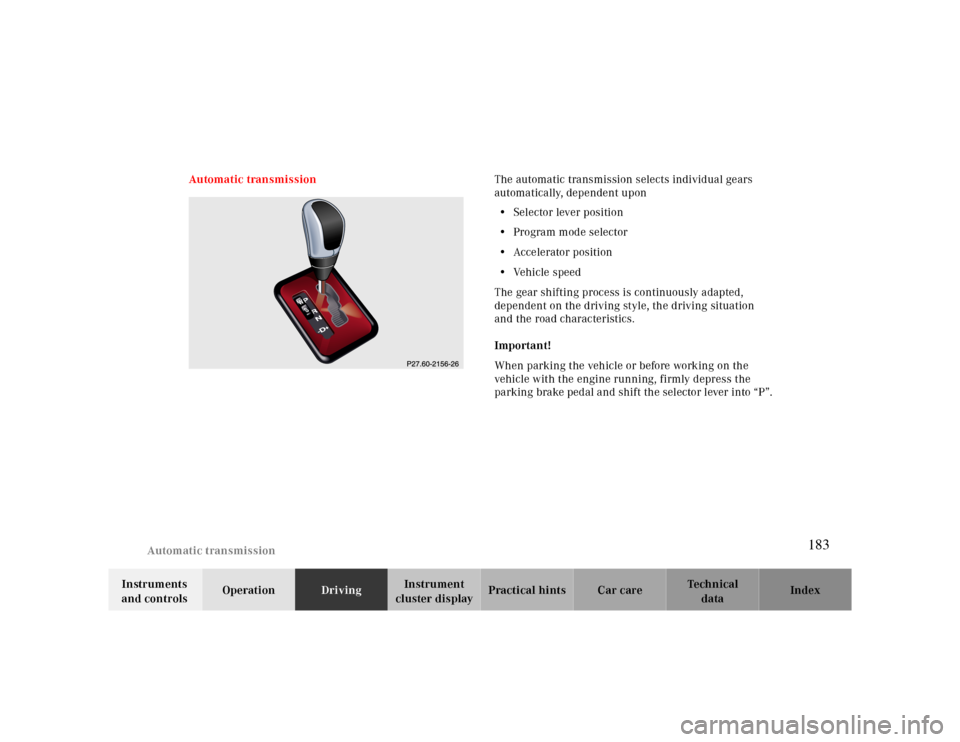
Automatic transmission
Te ch n ica l
data Instruments
and controlsOperationDrivingInstrument
cluster displayPractical hints Car care Index Automatic transmissionThe automatic transmission selects individual gears
automatically, dependent upon
•Selector lever position
•Program mode selector
•Accelerator position
•Vehicle speed
The gear shifting process is continuously adapted,
dependent on the driving style, the driving situation
and the road characteristics.
Important!
When parking the vehicle or before working on the
vehicle with the engine running, firmly depress the
parking brake pedal and shift the selector lever into “P”.
183
Page 184 of 323
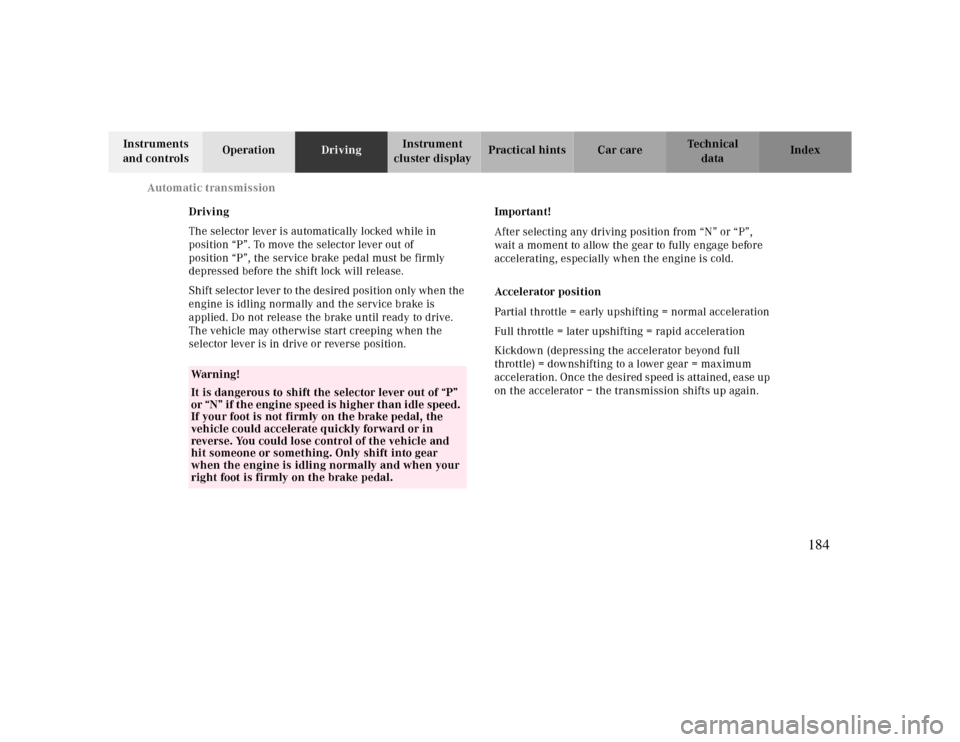
Automatic transmission
Te ch n ica l
data Instruments
and controlsOperationDrivingInstrument
cluster displayPractical hints Car care Index
Driving
The selector lever is automatically locked while in
position “P”. To move the selector lever out of
position “P”, the service brake pedal must be firmly
depressed before the shift lock will release.
Shift selector lever to the desired position only when the
engine is idling normally and the service brake is
applied. Do not release the brake until ready to drive.
The vehicle may otherwise start creeping when the
selector lever is in drive or reverse position.Important!
After selecting any driving position from “N” or “P”,
wait a moment to allow the gear to fully engage before
accelerating, especially when the engine is cold.
Accelerator position
Partial throttle = early upshifting = normal acceleration
Full throttle = later upshifting = rapid acceleration
Kickdown (depressing the accelerator beyond full
throttle) = downshifting to a lower gear = maximum
acceleration. Once the desired speed is attained, ease up
on the accelerator – the transmission shifts up again.
Warning!
It is dangerous to shift the selector lever out of “P”
or “N” if the engine speed is higher than idle speed.
If your foot is not firmly on the brake pedal, the
vehicle could accelerate quickly forward or in
reverse. You could lose control of the vehicle and
hit someone or something. Only shift into gear
when the engine is idling normally and when your
right foot is firmly on the brake pedal.
184
Page 185 of 323
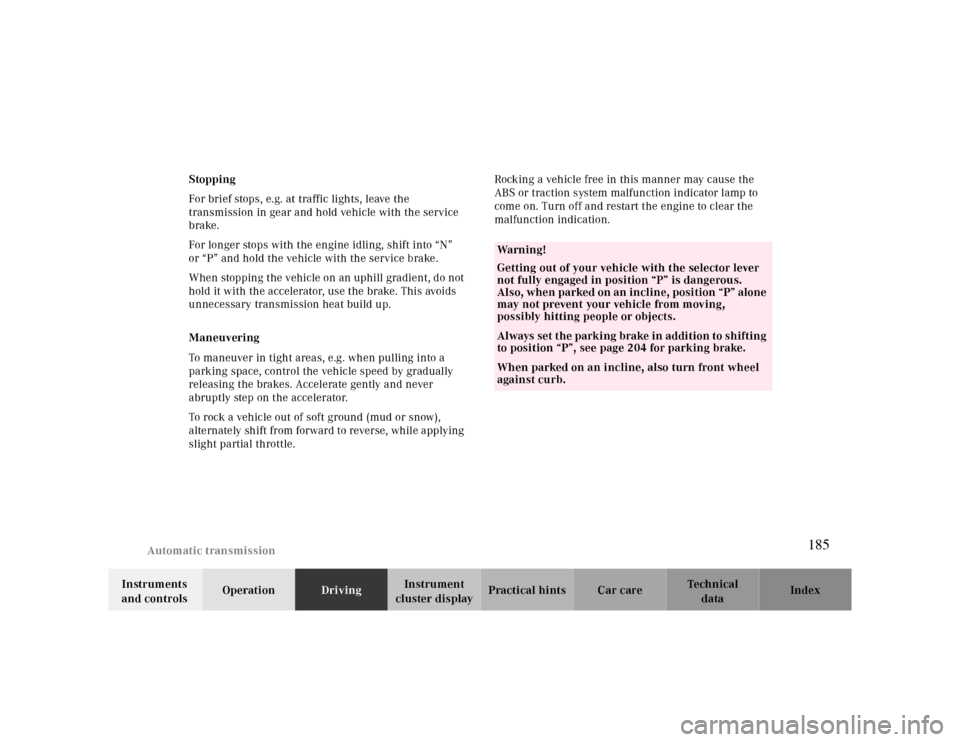
Automatic transmission
Te ch n ica l
data Instruments
and controlsOperationDrivingInstrument
cluster displayPractical hints Car care Index Stopping
For brief stops, e.g. at traffic lights, leave the
transmission in gear and hold vehicle with the service
brake.
For longer stops with the engine idling, shift into “N”
or “P” and hold the vehicle with the service brake.
When stopping the vehicle on an uphill gradient, do not
hold it with the accelerator, use the brake. This avoids
unnecessary transmission heat build up.
Maneuvering
To maneuver in tight areas, e.g. when pulling into a
parking space, control the vehicle speed by gradually
releasing the brakes. Accelerate gently and never
abruptly step on the accelerator.
To rock a vehicle out of soft ground (mud or snow),
alternately shift from forward to reverse, while applying
slight partial throttle.Rocking a vehicle free in this manner may cause the
ABS or traction system malfunction indicator lamp to
come on. Turn off and restart the engine to clear the
malfunction indication.
Wa r n i n g !
Getting out of your vehicle with the selector lever
not fully engaged in position “P” is dangerous.
Also, when parked on an incline, position “P” alone
may not prevent your vehicle from moving,
possibly hitting people or objects.Always set the parking brake in addition to shifting
to position “P”, see page 204 for parking brake. When parked on an incline, also turn front wheel
against curb.
185
Page 186 of 323
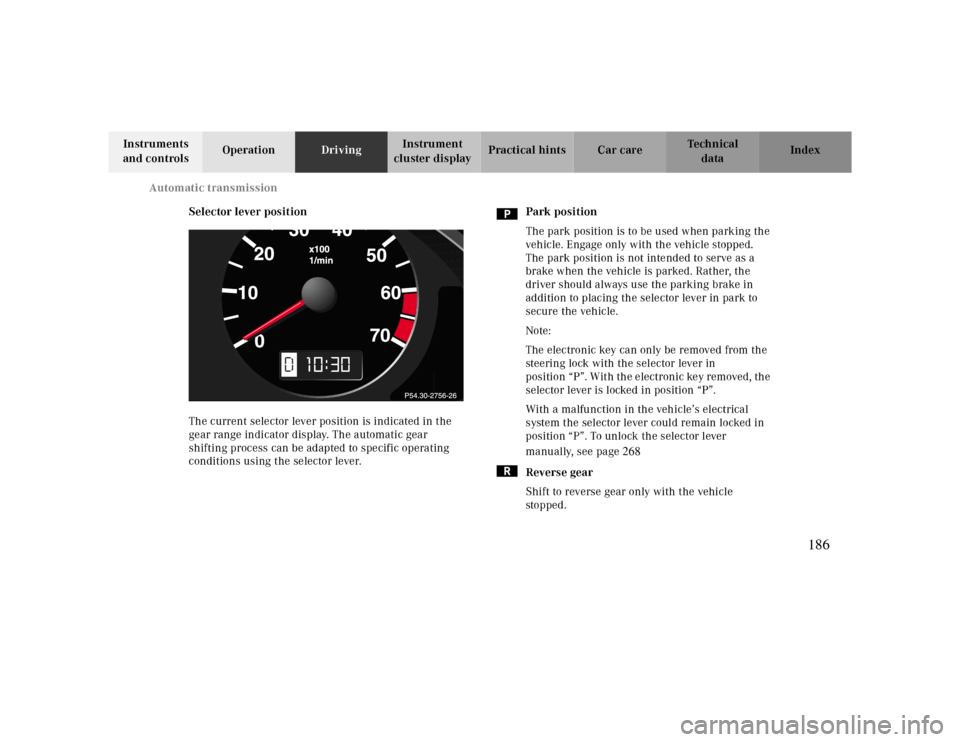
Automatic transmission
Te ch n ica l
data Instruments
and controlsOperationDrivingInstrument
cluster displayPractical hints Car care Index
Selector lever position
The current selector lever position is indicated in the
gear range indicator display. The automatic gear
shifting process can be adapted to specific operating
conditions using the selector lever.Park position
The park position is to be used when parking the
vehicle. Engage only with the vehicle stopped.
The park position is not intended to serve as a
brake when the vehicle is parked. Rather, the
driver should always use the parking brake in
addition to placing the selector lever in park to
secure the vehicle.
Note:
The electronic key can only be removed from the
steering lock with the selector lever in
position “P”. With the electronic key removed, the
selector lever is locked in position “P”.
With a malfunction in the vehicle’s electrical
system the selector lever could remain locked in
position “P”. To unlock the selector lever
manually, see page268
Reverse gear
Shift to reverse gear only with the vehicle
sto p ped .
10
186
Page 187 of 323
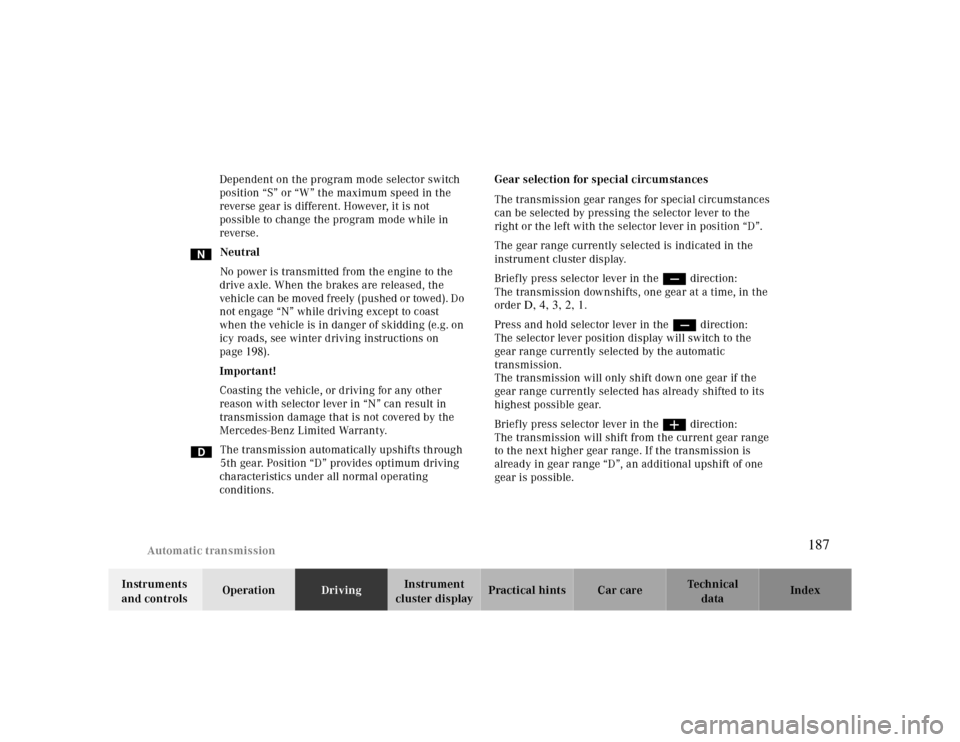
Automatic transmission
Te ch n ica l
data Instruments
and controlsOperationDrivingInstrument
cluster displayPractical hints Car care Index Dependent on the program mode selector switch
position “S” or “W” the maximum speed in the
reverse gear is different. However, it is not
possible to change the program mode while in
reverse.
Neutral
No power is transmitted from the engine to the
drive axle. When the brakes are released, the
vehicle can be moved freely (pushed or towed). Do
not engage “N” while driving except to coast
when the vehicle is in danger of skidding (e.g. on
icy roads, see winter driving instructions on
page198).
Important!
Coasting the vehicle, or driving for any other
reason with selector lever in “N” can result in
transmission damage that is not covered by the
Mercedes-Benz Limited Warranty.
The transmission automatically upshifts through
5th gear. Position “D” provides optimum driving
characteristics under all normal operating
conditions.Gear selection for special circumstances
The transmission gear ranges for special circumstances
can be selected by pressing the selector lever to the
right or the left with the selector lever in position “D”.
The gear range currently selected is indicated in the
instrument cluster display.
Briefly press selector lever in the çdirection:
The transmission downshifts, one gear at a time, in the
orderD, 4, 3, 2, 1.
Press and hold selector lever in the çdirection:
The selector lever position display will switch to the
gear range currently selected by the automatic
transmission.
The transmission will only shift down one gear if the
gear range currently selected has already shifted to its
highest possible gear.
Briefly press selector lever in the ædirection:
The transmission will shift from the current gear range
to the next higher gear range. If the transmission is
already in gear range “D”, an additional upshift of one
gear is possible.
187
Page 188 of 323
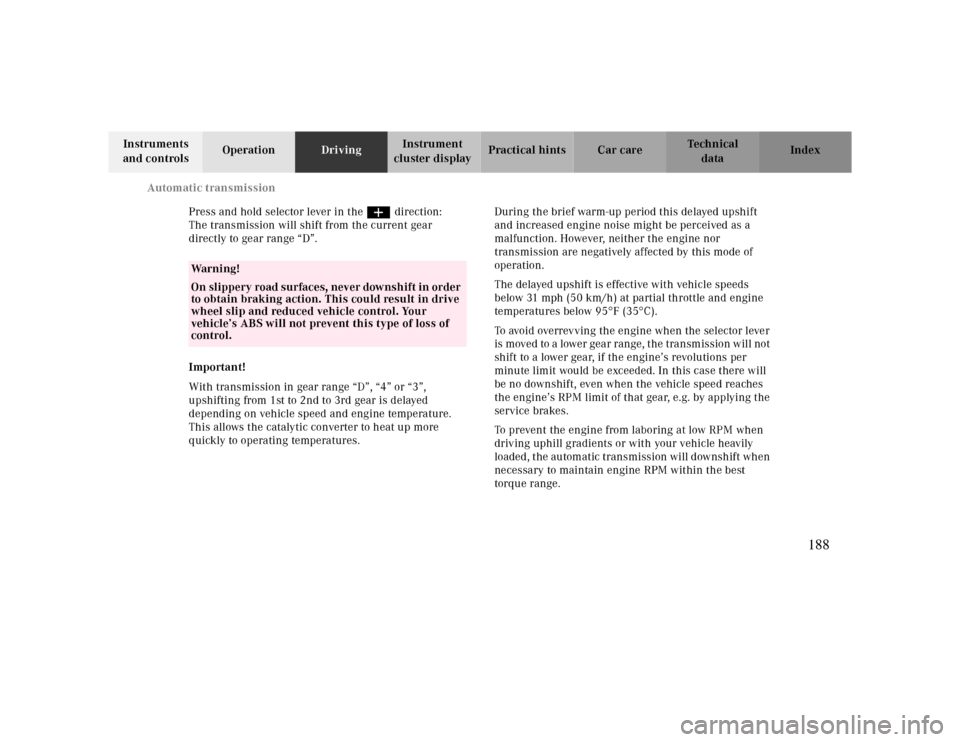
Automatic transmission
Te ch n ica l
data Instruments
and controlsOperationDrivingInstrument
cluster displayPractical hints Car care Index
Press and hold selector lever in the ædirection:
The transmission will shift from the current gear
directly to gear range “D”.
Important!
With transmission in gear range “D”, “4” or “3”,
upshifting from 1st to 2nd to 3rd gear is delayed
depending on vehicle speed and engine temperature.
This allows the catalytic converter to heat up more
quickly to operating temperatures.During the brief warm-up period this delayed upshift
and increased engine noise might be perceived as a
malfunction. However, neither the engine nor
transmission are negatively affected by this mode of
operation.
The delayed upshift is effective with vehicle speeds
below 31 mph (50 km/h) at partial throttle and engine
temperatures below 95°F (35°C).
To avoid overrevving the engine when the selector lever
is moved to a lower gear range, the transmission will not
shift to a lower gear, if the engine’s revolutions per
minute limit would be exceeded. In this case there will
be no downshift, even when the vehicle speed reaches
the engine’s RPM limit of that gear, e.g. by applying the
service brakes.
To prevent the engine from laboring at low RPM when
driving uphill gradients or with your vehicle heavily
loaded, the automatic transmission will downshift when
necessary to maintain engine RPM within the best
torque range.
Warning!
On slippery road surfaces, never downshift in order
to obtain braking action. This could result in drive
wheel slip and reduced vehicle control. Your
vehicle’s ABS will not prevent this type of loss of
control.
188
Page 189 of 323
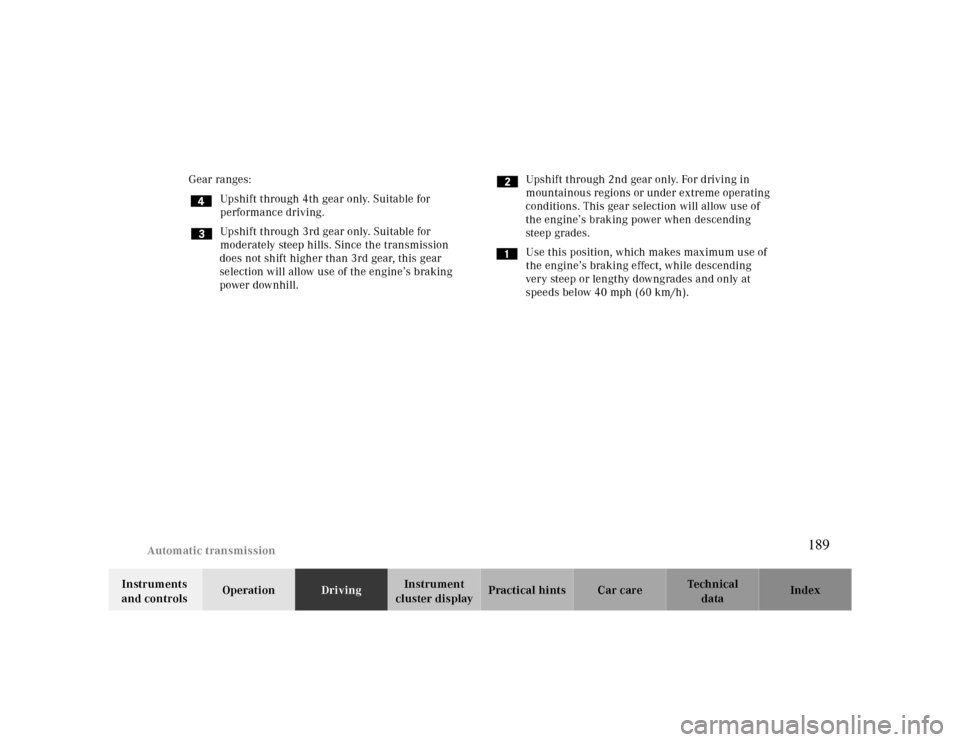
Automatic transmission
Te ch n ica l
data Instruments
and controlsOperationDrivingInstrument
cluster displayPractical hints Car care Index Gear ranges:
Upshift through 4th gear only. Suitable for
performance driving.
Upshift through 3rd gear only. Suitable for
moderately steep hills. Since the transmission
does not shift higher than 3rd gear, this gear
selection will allow use of the engine’s braking
power downhill.Upshift through 2nd gear only. For driving in
mountainous regions or under extreme operating
conditions. This gear selection will allow use of
the engine’s braking power when descending
steep grades.
Use this position, which makes maximum use of
the engine’s braking effect, while descending
very steep or lengthy downgrades and only at
speeds below 40 mph (60 km/h).
189